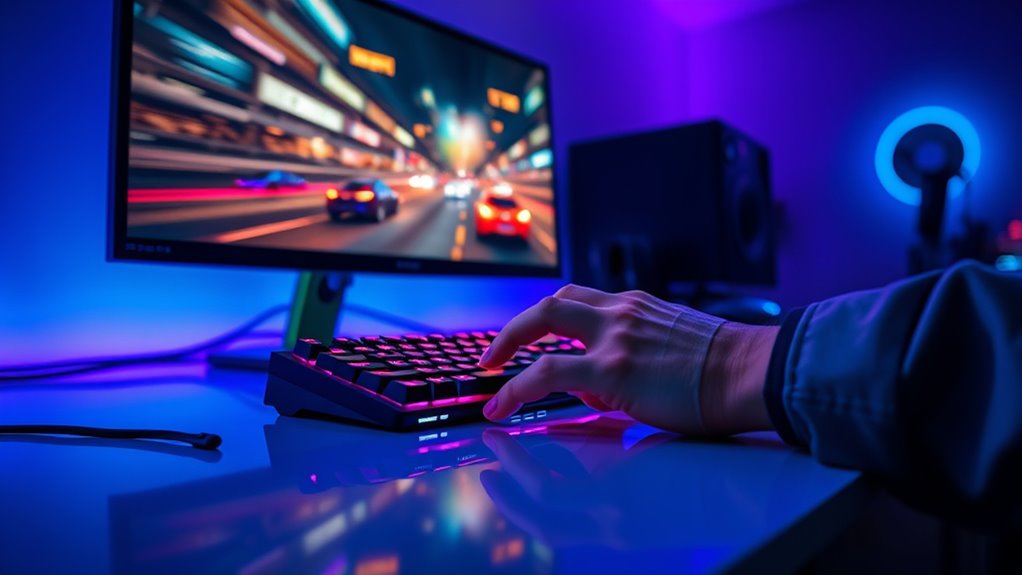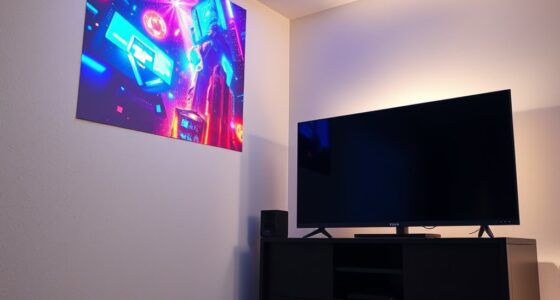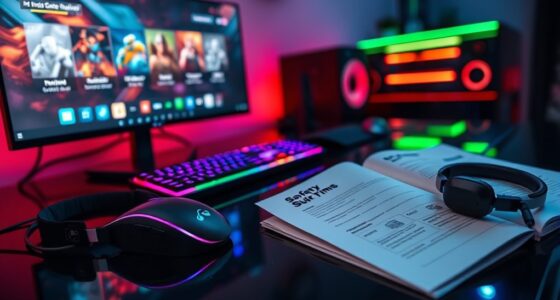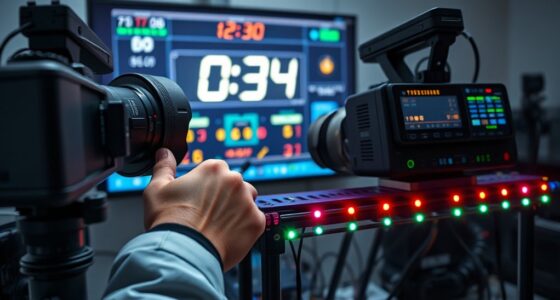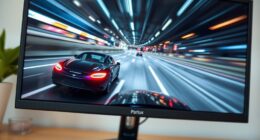Input lag is the delay between when you press a button or move a control and when the action appears on screen. It includes factors like controller response time and how quickly your display refreshes. High input lag can cause frustrating delays, missed shots, and mistakes, especially in fast-paced games. Minimizing it boosts your performance and overall experience. To understand how to reduce lag and optimize your gaming setup, keep exploring the details ahead.
Key Takeaways
- Input lag is the delay between a player’s control input and the on-screen action.
- It affects gameplay responsiveness, impacting accuracy, timing, and overall gaming experience.
- Higher input lag can cause frustration, missed shots, and decreased competitiveness.
- It is influenced by display refresh rates, response times, hardware, and connection quality.
- Reducing input lag involves optimizing device settings, using high-refresh-rate monitors, and ensuring stable connections.
Defining Input Lag and Its Components
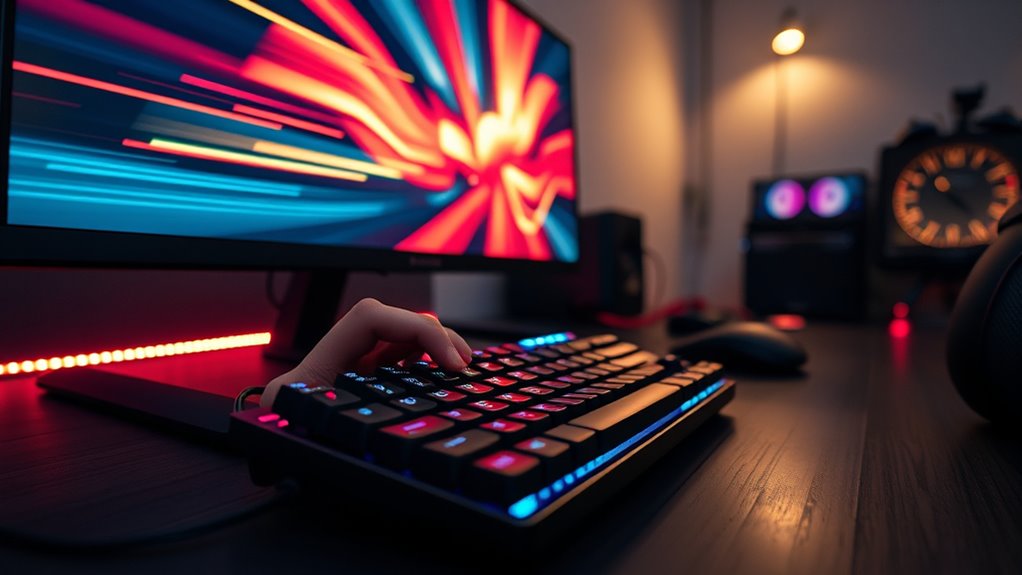
Understanding input lag begins with recognizing that it’s the delay between when you make a control input, like pressing a button or moving a joystick, and when that action appears on the screen. Controller latency is a key component, representing the time it takes for your device to send your input to the gaming console or PC. Another important factor is the refresh rate of your display, which determines how often the screen updates per second. A higher refresh rate can reduce the perceived input lag because the screen refreshes more frequently, displaying your actions sooner. Together, controller latency and refresh rate shape the overall input lag you experience. Minimizing both helps create a more responsive gaming experience, giving you faster, more accurate control over your gameplay. Additionally, understanding how display technology impacts input lag can help you choose equipment that enhances responsiveness.
How Input Lag Affects Gameplay Performance
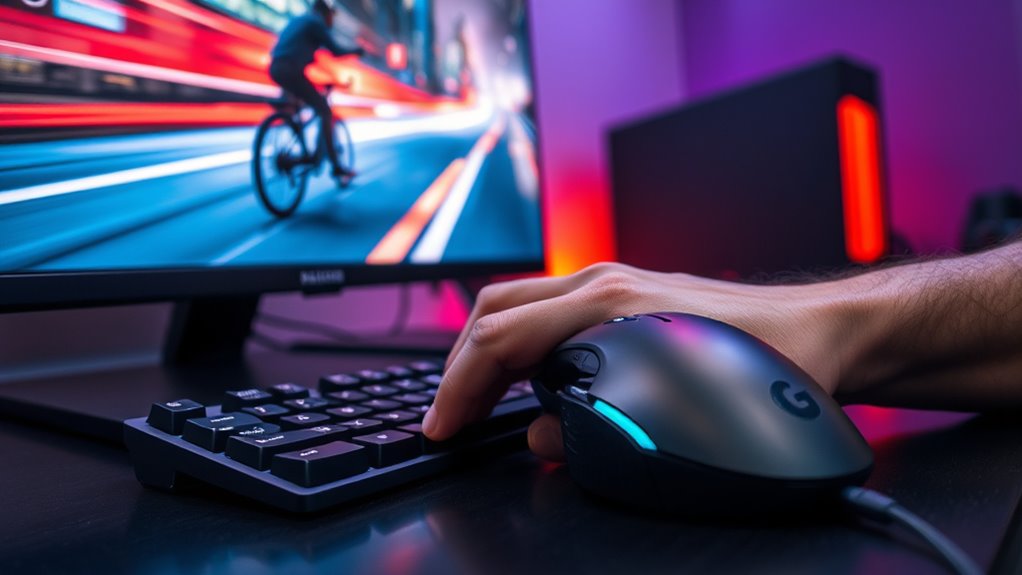
Input lag directly impacts your ability to react quickly and accurately during gameplay. When your controller’s responsiveness feels delayed, or network latency causes data to arrive late, your actions won’t match your intentions. This can lead to missed shots, mistimed maneuvers, or slow reactions in fast-paced games. You might find yourself struggling to keep up with opponents or executing strategies smoothly. Additionally, understanding battery technologies can help optimize your gaming setup with portable power solutions that ensure consistent performance.
Understanding how input lag affects performance involves recognizing:
- Delayed controller responses can cause frustration and mistakes
- Increased network latency hampers real-time decision-making
- Both factors reduce your overall gameplay precision and competitiveness
Minimizing input lag ensures your commands are registered instantly, giving you a clearer advantage and a more immersive gaming experience.
Factors That Contribute to Increased Input Delay
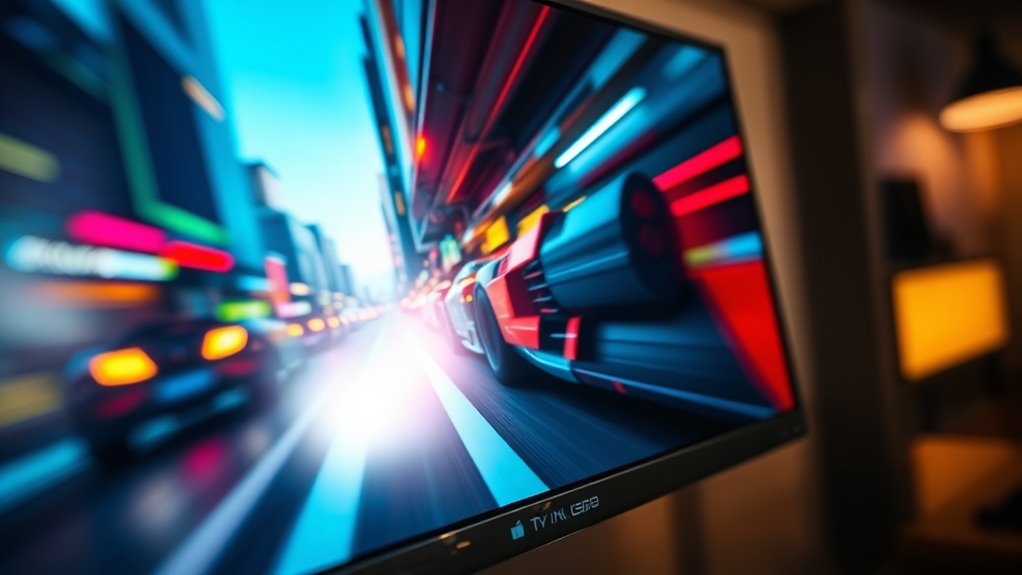
Several factors can increase input delay, making your gameplay less responsive. One major element is the refresh rate of your monitor; a lower refresh rate results in fewer updates per second, causing delays between your input and what you see. Cable quality also plays a pivotal role—poor-quality cables can introduce signal interference, adding lag. Other contributors include outdated hardware, background processes, and settings like V-Sync. These issues amplify your frustration and hinder performance when quick reactions matter most. Additionally, sound healing science suggests that environmental factors like ambient noise can indirectly affect focus and reaction times during gameplay.
Measuring and Testing Input Lag

To accurately assess your input lag, you’ll need the right testing tools and devices designed for precise measurements. Understanding standardized measurement methods helps guarantee your results are consistent and reliable. Interpreting these results correctly allows you to make informed decisions about optimizing your gaming setup.
Testing Tools and Devices
Measuring input lag accurately is essential for gamers aiming to optimize their setup, and choosing the right tools makes all the difference. Devices like high-speed cameras, specialized testing software, and lag testers help you quantify delays precisely. These tools can reveal how controller sensitivity affects your response times and highlight the impact of network latency on gameplay. When selecting testing equipment, consider the following:
- The ability to capture real-time input and display delays visually
- Compatibility with your gaming hardware and display setups
- Accuracy in measuring both controller and display lag
- The importance of understanding the contrast ratio in your display to ensure optimal visual performance during testing
Using these tools, you can identify bottlenecks and fine-tune your system for minimal input lag, ensuring your gaming experience is as responsive as possible.
Standardized Measurement Methods
Accurately measuring input lag requires standardized methods that guarantee consistent and reliable results. These methods guarantee your input lag calibration is precise and comparable across devices. Standardized testing involves specific procedures, such as using high-speed cameras or specialized tools, to record the delay between input and display response. Visualize the process with this table:
| Step | Method | Purpose |
|---|---|---|
| 1 | Trigger input at device | Initiate measurement |
| 2 | Record response with camera | Capture display reaction |
| 3 | Analyze timing data | Determine input lag |
This structured approach helps you accurately assess input lag, guaranteeing your gaming setup performs at its best and consistently. Additionally, understanding Soul Sanctuaries can provide insights into creating a calming environment that may indirectly improve your gaming focus and performance.
Interpreting Results Accurately
Interpreting input lag results requires careful analysis to guarantee your gaming experience is as responsive as possible. You should consider factors like color calibration, which affects visual clarity and can influence perceived latency, and audio synchronization, essential for matching visual cues with sound cues. When testing, look beyond raw numbers to understand how different settings impact gameplay. Additionally, using proper testing equipment such as headphones can improve the accuracy of your measurements.
To interpret results effectively, keep in mind:
- Variations in display settings can skew latency measurements.
- Inconsistent color calibration might mask true input delay.
- Audio synchronization issues can create a false sense of lag, impacting your perception of responsiveness.
Accurate assessment involves considering these elements to ensure your gaming setup delivers minimal lag and peak performance.
Comparing Input Lag Across Different Devices and Displays
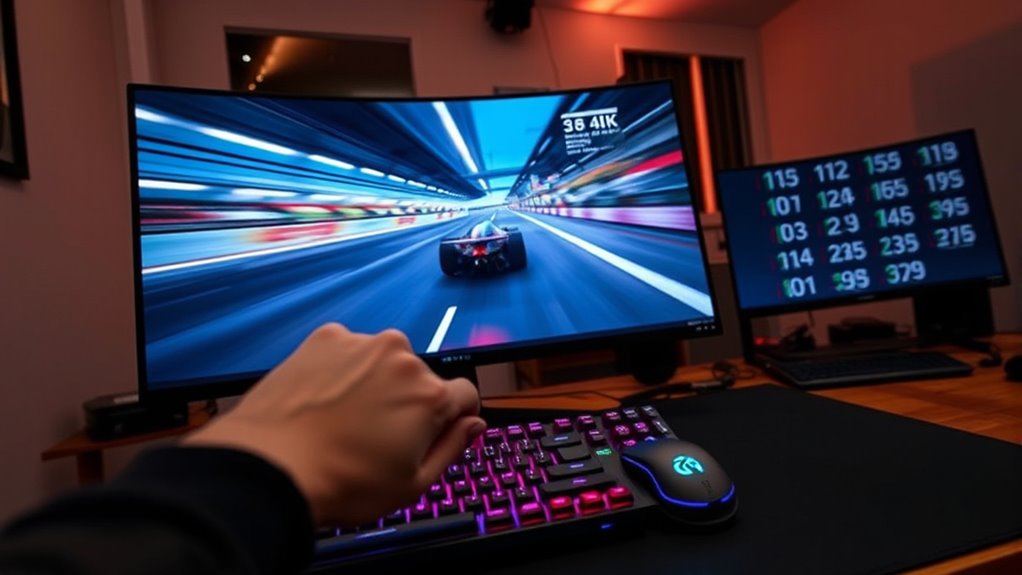
When comparing input lag, you’ll notice differences between consoles and PCs due to hardware and processing speeds. Display technology, like LCDs or OLEDs, also impacts latency, especially with gaming mode settings optimized for lower delay. Understanding how these factors interact helps you choose the best device and display for a smoother gaming experience. Additionally, privacy policies influence user data collection, which can indirectly affect how gaming platforms optimize performance for users.
Console vs. PC Latency
While both consoles and PCs aim for low input lag, their latency levels can differ markedly depending on hardware and display choices. On PCs, higher refresh rates and customizable settings often reduce input lag, especially with a responsive monitor. Consoles typically have fixed refresh rates, which can limit latency improvements but provide consistent performance. Your controller sensitivity also plays a role, as more responsive settings can minimize perceived delay. To optimize latency:
- Use a high refresh rate display for faster updates
- Adjust controller sensitivity for quicker response
- Choose hardware with low latency support
Additionally, understanding input lag measurement techniques can help you better assess and improve your setup. Ultimately, PCs often offer lower latency due to customizable settings, but consoles can still deliver excellent performance with the right display and configuration. Your setup and preferences heavily influence overall input responsiveness.
Display Technology Differences
Display technology plays a significant role in how much input lag you experience during gaming, with different devices and screens offering varying performance levels. Higher refresh rates, like 120Hz or 144Hz, can reduce input lag by updating images more frequently, giving you a smoother response. Response time, measured in milliseconds, indicates how quickly a pixel changes from one color to another; lower response times minimize motion blur and delay, improving responsiveness. LCDs with fast response times and high refresh rates typically have less input lag compared to older CRT or plasma screens. Additionally, gaming monitors often optimize these factors, providing a more immediate reaction to your inputs. Choosing the right display technology guarantees you get the most responsive experience, vital for fast-paced, competitive gaming scenarios. Furthermore, understanding AI security vulnerabilities and advancements can help you select displays and systems that incorporate the latest safeguards for a safer gaming environment.
Gaming Mode Optimization
Optimizing gaming mode settings can considerably reduce input lag across different devices and displays. By adjusting settings like controller calibration, you guarantee your inputs register accurately and promptly. Fine-tuning audio synchronization prevents delays between sound cues and visuals, enhancing responsiveness. Comparing input lag across devices involves understanding each display’s capabilities and how they handle latency. For instance, some monitors have faster refresh rates or specialized gaming modes that minimize lag. To get the most out of your setup, consider these factors:
- Enable gaming mode or low-latency settings on your display
- Regularly calibrate your controller for precise response
- Optimize audio sync to prevent audio-visual delays
- Understanding input lag measurement helps you choose devices with lower latency for a better gaming experience
These adjustments help create a smoother, more responsive gaming experience, giving you an edge in fast-paced games.
Tips to Minimize Input Lag for Better Gaming
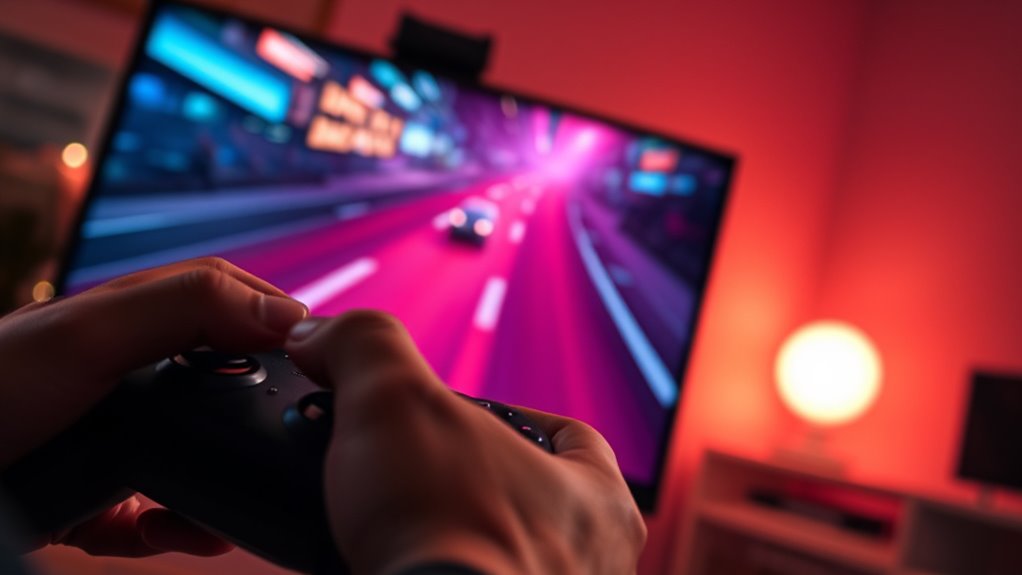
To improve your gaming experience, taking steps to reduce input lag is essential. Adjust your controller sensitivity settings to find a balance that offers quick response without sacrificing accuracy. Lower sensitivity can cause delays, while higher sensitivity improves responsiveness. Also, minimize audio delay by connecting quality audio devices or using game settings that sync audio with visuals. Additionally, disable unnecessary background processes and enable gaming mode on your console or PC. Keep your display’s refresh rate synchronized with your graphics card’s output. Use a wired connection instead of Wi-Fi for more stable data transfer.
| Tip | Benefit |
|---|---|
| Adjust controller sensitivity | Faster, more accurate inputs |
| Minimize audio delay | Better synchronization between sound and visuals |
| Use wired connections | Reduces latency and interference |
| Enable gaming mode | Prioritizes game data for smoother play |
The Impact of Input Lag on Competitive Gaming
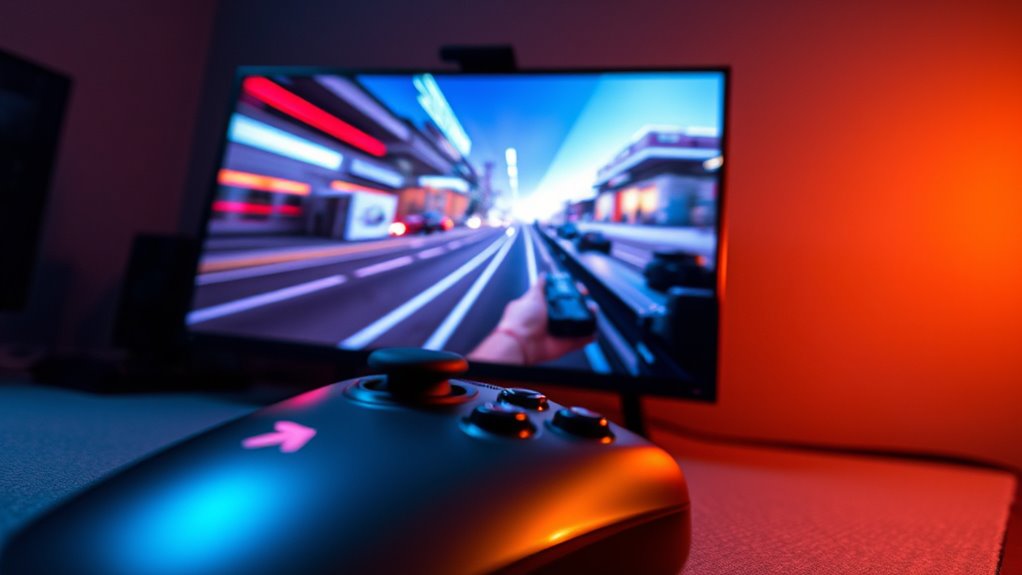
Reducing input lag not only improves general gaming performance but also has a direct impact on competitive play. In high-stakes situations, even slight controller response delays or keyboard latency can determine victory or defeat. Fast and accurate inputs are vital for reacting to opponents’ moves and executing strategies flawlessly. When input lag is minimized, your actions feel more immediate, giving you a competitive edge. This allows you to respond quicker, maintain better timing, and stay more focused on gameplay.
Minimizing input lag enhances responsiveness, reaction times, and competitive edge in high-stakes gaming situations.
Consider these implications:
- Enhanced controller responsiveness leads to more precise control.
- Lower keyboard latency improves reaction times during fast-paced moments.
- Reduced delay ensures actions match intent, critical in competitive settings.
Future Technologies and Trends in Reducing Input Delay
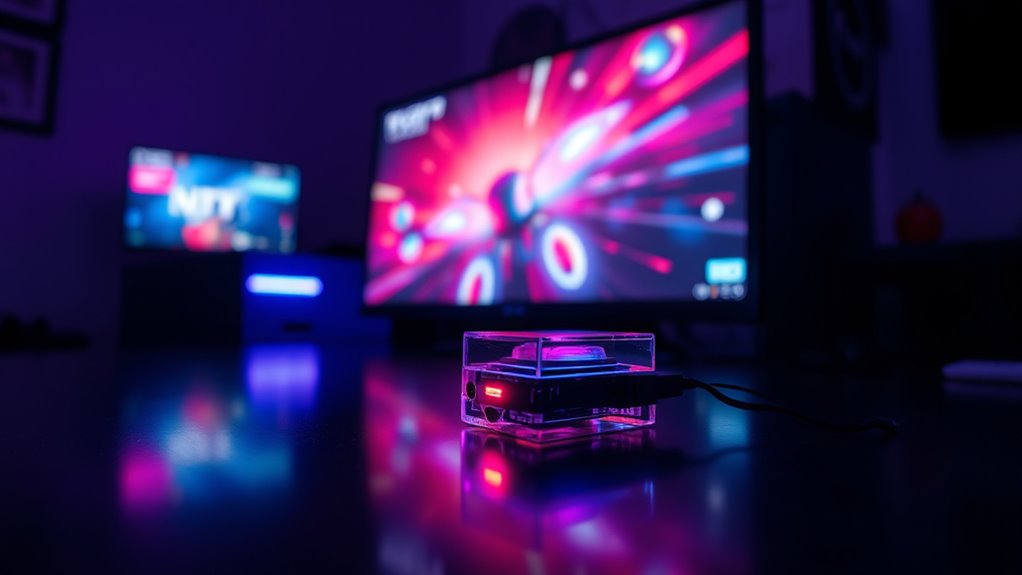
As technology advances, new innovations are emerging to further decrease input delay and enhance gaming responsiveness. Virtual reality systems are integrating faster processing and optimized tracking to minimize lag, creating more immersive experiences without noticeable delays. Haptic feedback technology is also evolving, providing more immediate and precise tactile responses that synchronize seamlessly with on-screen actions. Developers are exploring advanced algorithms and edge computing to reduce latency further, ensuring that input commands translate instantaneously. Additionally, wireless controllers are improving with low-latency Bluetooth protocols and dedicated chips to cut down transmission delays. These trends aim to deliver a more fluid experience, making gameplay feel more natural and reactive. By embracing these innovations, gamers can expect future gaming setups to feel more responsive and immersive than ever before.
Frequently Asked Questions
Can Input Lag Be Completely Eliminated in Gaming Setups?
Input lag can’t be completely eliminated in gaming setups, but you can minimize it with hardware optimization and better display technology. Upgrading to a high-refresh-rate monitor, using low-latency input devices, and ensuring your hardware is optimized helps reduce lag considerably. While some delay is unavoidable due to processing and display limitations, these improvements make your gaming experience much more responsive and enjoyable.
How Does Input Lag Affect Virtual Reality Gaming Experiences?
Imagine you’re in a sci-fi movie—input lag can break that illusion in VR gaming. It delays your actions, disrupting VR immersion and making movements feel out of sync, which may cause motion sickness. High input lag diminishes realism and comfort, leaving you frustrated. To enjoy smooth, immersive experiences, you need low input lag, so your actions match what you see, keeping you fully engaged without the dizziness.
Are There Specific Game Genres More Sensitive to Input Delay?
Certain game genres, like first-person shooters and fighting games, are more sensitive to input delay because they demand quick reaction times. You’ll notice even slight input lag impacts your reaction time, making it harder to aim accurately or execute precise moves. Action-packed and competitive games require minimal input lag to guarantee your responses are swift and your gameplay remains smooth. Reducing input delay gives you a competitive edge and a more satisfying gaming experience.
What Role Does Internet Latency Play Alongside Hardware Input Lag?
Internet latency directly impacts your gaming experience by adding delay to your actions, which combines with hardware input lag. When your network is unstable or has high latency, your commands take longer to reach the game server, causing noticeable lag. To minimize this, focus on network stability and bandwidth optimization, ensuring your connection is consistent and fast. This way, your in-game responses stay sharp, giving you a smoother, more responsive experience.
Can Software Updates Reduce Existing Input Lag Issues?
Much like a skilled conductor fine-tunes an orchestra, software updates can reduce input lag through software optimization and firmware improvements. By installing these updates, you enhance device responsiveness, ensuring commands reach your game faster. While they might not eliminate all lag, they often markedly improve performance, giving you a smoother, more immediate gaming experience. Keep your firmware current to stay in sync and reduce frustrating delays.
Conclusion
Understanding input lag helps you enjoy smoother gameplay and stay competitive. Did you know that even a 16-millisecond delay can affect reaction times? By choosing the right devices and optimizing settings, you can reduce lag and improve your gaming experience. Staying aware of how input delay impacts performance keeps you ahead of the game. So, take control, minimize delays, and level up your gameplay—every millisecond counts!
